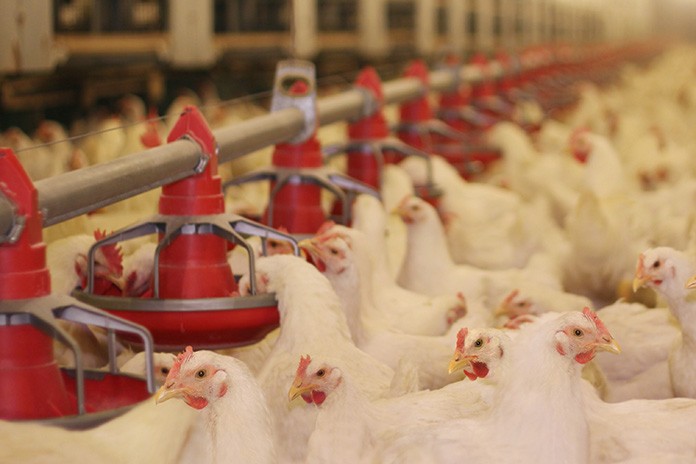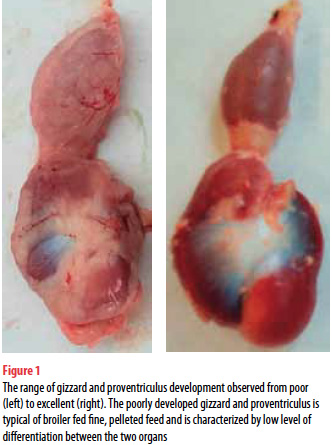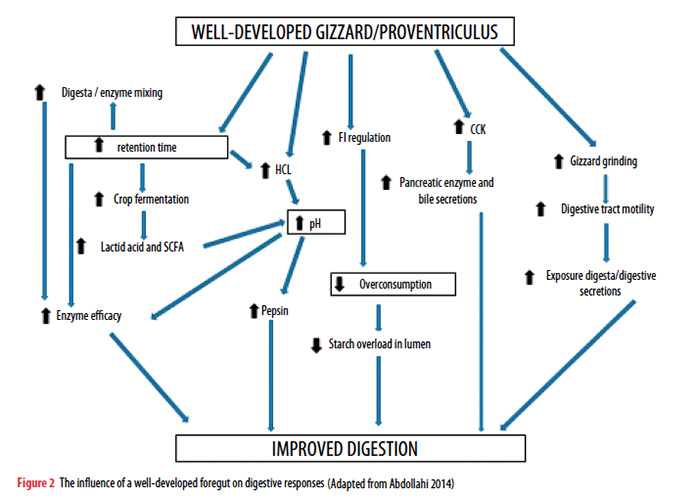
Anatomy of the stomach
The stomach of the chicken consists of two chambers, the proventriculus or glandular stomach and the gizzard or muscular stomach.
The proventriculus is the site of acid secretion while the gizzard is involved in the physical phase of digestion and is the site where the majority of gastric proteolysis occurs. The proventriculus is small and tubular; the walls are thick and are lined with gastric glands distributed throughout that secrete hydrochloric acid, pepsin and mucus.
The gizzard is well developed with a thick muscle coating, and should be easily distinguished from the proventriculus if adequately stimulated by the feed components (Figure 1).
The muscles of the gizzard are arranged to allow for both a rotary and crushing action during contractions, perfectly adapted to the grinding requirements of ingested feed. The epithelium of the gizzard is coated with a hardened cuticle known as the koilin layer, to protect the organ from acid, proteolytic enzymes and physical damage from grinding. The flow of feed particles into the small intestines are regulated by the pyloric sphincter, and in an adequately developed gizzard this flow should be particle size dependent.

The gizzard: the modulator of digestion
The gizzard’s role as the central modulator of digestion has received significant interest amongst the scientific community and industry over the last 20 years.
Of particular interest is the responsiveness of the gizzard to specific raw materials/feed constituents referred to here as structural components and the subsequent improvements in performance.
A well-developed gizzard is correlated with heightened proventriculus function and together this results in a multitude of positive responses in the bird (Figure 2), including reduced gizzard pH, heightening pepsin activity, increased satiation, longer retention of feed particles in the foregut therefore increasing exposure to digestive processes, and perhaps most importantly, controlled digesta flow into the lumen.
In a standard commercial diet containing few or no structural components, retention time of feed in the gizzard is likely to be between 30-60 minutes. By stimulating gizzard development via the addition of structure (e.g. 3% oat hulls or 20% whole wheat) mean retention time will increase up to 120 minutes. In addition, gizzard development is generally associated with reduced pH of gastric contents, which in conjunction with a prolonged retention time provides more suitable conditions for effective pepsin activity, and potentially the solubilization of minerals present in the feed.
Studies have shown that a well-developed gizzard results in a more homogenous particle size of the digesta passing into the small intestines as well as a more controlled flow, reducing the potential for a starch overload in the lumen. This combination of flow regulation and particle size homogenization of digesta, leading to optimized enzyme/substrate interactions and reduced potential for microbial colonization, is likely the primary cause of the improvements in starch digestion, and therefore a reduction in Feed conversion ratio (FCR).

Structure: particle size and hardness
A well-developed gizzard and proventriculus is achieved in the presence of structure, defined as the size and internal binding strength or hardness of feed particles. Structure in the diet can come from a variety of sources for example, cereal hulls or wood shavings, as well as whole grains.
The use of whole wheat, in particular, has become common practice across Western Europe, following sufficient evidence in the literature as to the potential benefits, with up to 40% whole wheat included in finisher rations. This has financial benefits for the farmer who has the freedom to determine whole wheat inclusion based on price and local availability in addition to the potential improvements in FCR. However, at high levels of whole wheat inclusion, uniformity of flocks may be compromised due to uneven feed intake, and separation of the whole wheat grain from the concentrated diet.
Based on literature, improvements in performance have been especially pronounced in birds when cereal hulls have been included as a structural element in the diet.
Cereal hulls may also be referred to as coarse or insoluble fiber, composed of mostly cellulose and lignin. Cereal hulls, when available maybe a more desirable source of structure than whole wheat as they can be included in the main mixer during feed production and then pelleted, avoiding diet separation and irregular feed intake.
The modern broiler is capable of adapting to large coarse fiber dilutions, as high as 15%, without negatively affecting growth or FCR. When included on top or as a dilution at modest levels (e.g. 2-5%) cereal hulls have brought about significant improvements in feed conversion.
Studies involving the inclusion of structural components, both in the form of whole grains and/or cereal hulls, have recorded improvements in apparent metabolisable energy (AME) between 3-8% (depending on the inclusion level and type of structure), and have resulted in 2-6 points improvements in FCR. The driving force behind this is enhanced gizzard function indicated by significant increases in relative gizzard and proventriculus weights in birds exposed to structural components as a result of increased grinding activity.
The importance of both particle hardness and size is illustrated by studies involving the inclusion of finely or coarsely ground oat or barley hulls. Barley and oat hulls are high in lignified fiber and therefore are appropriate in terms of hardness but when finely ground they fail to yield the same benefits as coarsely ground hulls in terms of gizzard development.
Conversely, coarsely ground grains are not always hard enough (lower lignin content) to adequately resist grinding in the gizzard, long enough to induce development. A combination of particle size and hardness is necessary to resist grinding/particle size reduction, stimulating gizzard development. Once particles have been ground sufficiently and the limiting size is reached, they pass freely through the pyloric sphincter into the duodenum where digestion continues.
In this way a well-developed gizzard through its muscular contractions may optimize the passage of feed particles, through the pyloric sphincter into the duodenum, influencing the exposure of nutrients to digestive enzymes, and absorptive surfaces and therefore modulating the rate of digestion.
References are available on request

















